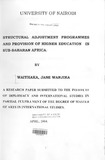| dc.contributor.author | Waithaka, Jane W | |
| dc.date.accessioned | 2012-11-13T12:42:58Z | |
| dc.date.available | 2012-11-13T12:42:58Z | |
| dc.date.issued | 2004 | |
| dc.identifier.uri | http://erepository.uonbi.ac.ke:8080/handle/123456789/6376 | |
| dc.description | (data migrated from the old repository) | |
| dc.description.abstract | Public spending on education can be a strong instrument for equity
expanding opportunities and raising the living standards for all, and especially for the poorest. This is the rationale behind government subsidizing education for its citizens. Higher education in most countries is therefore heavily dependent on government funding.
The introduction of Structural Adjustment Programmes (SAPs) in Sub-Saharan Africa (SSA) has seen a dramatic compression of per student
expenditure in higher education from the 1980s. This resulted in a crisis in the higher education sector as most of the SSA countries were least prepared for these changes. Lower spending in the higher education resulted in deterioration of quality of teaching and research. Institutions of higher education also operate under adverse conditions such as overcrowding, deteriorating physical facilities and lack of resources for required materials, laboratory consumables, and maintenance.
Austerity programmes have therefore had serious implications for the I region's development. This arises from the fact that illiterate or ill-educated people cannot participate effectively in the development process. Rationalization of public sector spending means increased fees and cost sharing, which many families cannot afford. This has raised uncertainty and discomfort among the SSA populace as concerns quality and access to higher education. SSA governments find it difficult to provide for human resource development to their poor populations, and yet human resources rest at the core of these nations' overall development.
This study looks at the nature of SSA economies in an attempt to find out the impact of SAPs on higher education systems. The study indicates that SSA is riddled with a myriad of economic problems that render the governments unable to subsidize higher education.
While higher education institutions in SSA have increased in number despite the introduction of SAPs in the 1980s and 1990s, the quality of education offered seems to be on the decline, with many higher education graduates in SSA missing job opportunities. Many of these institutions have been blamed for not being in tune with the job market, in that they keep on producing graduates from disciplines that are cheaper to maintain, but not from the needs of the job market.
There are calls for strong partnerships amongst all stakeholders in the education sector in order to diversify avenues for higher education provision. | en_US |
| dc.language.iso | en | en_US |
| dc.publisher | University of Nairobi, CEES, Kenya | en_US |
| dc.subject | Structural adjustment (Economic policy) -- Africa, Sub-Saharan) | en_US |
| dc.subject | Economic Policy -- Africa, Sub-Saharan | en_US |
| dc.title | Structural adjustment programmes and provision of higher education in sub-saharan Africa | en_US |
| dc.title.alternative | Thesis (MA) | en_US |
| dc.type | Thesis | en_US |

